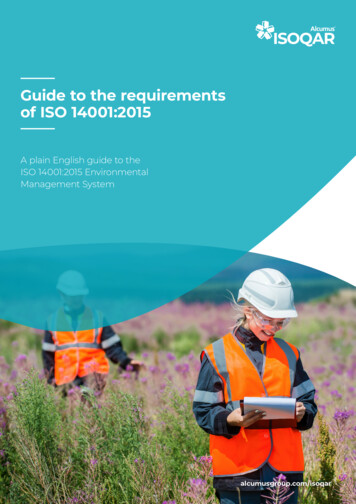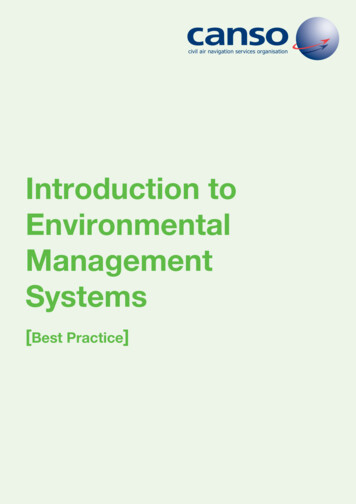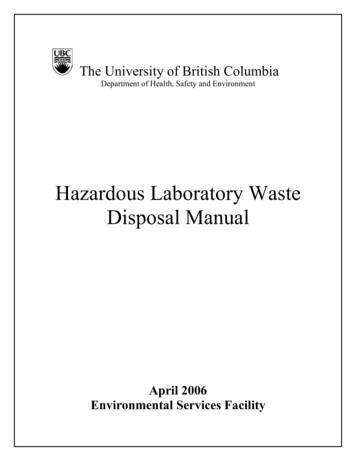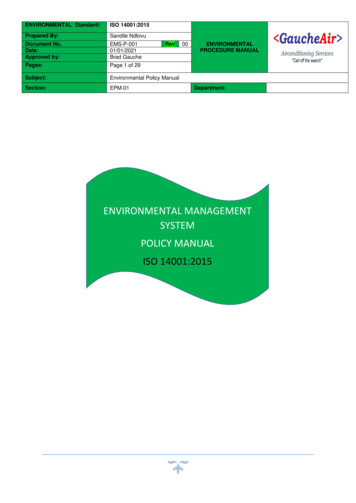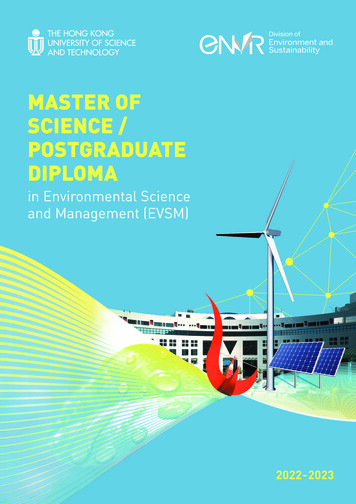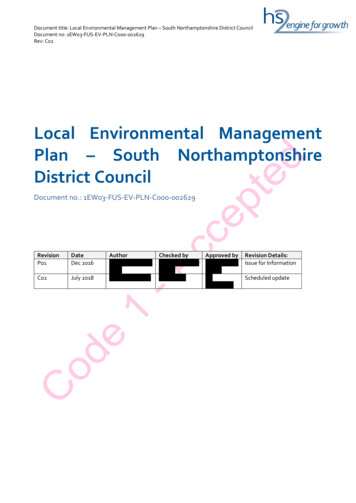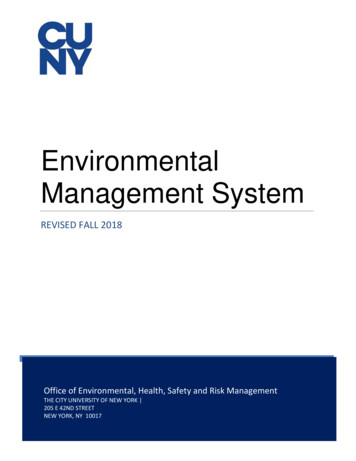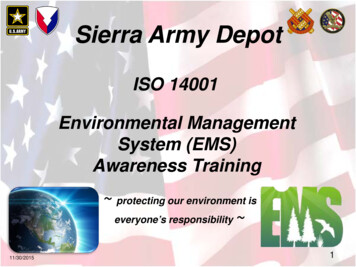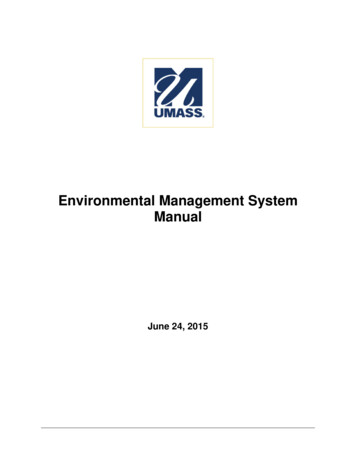
Transcription
Environmental Management SystemManualJune 24, 2015
EMS ManualTable of Contents1 INTRODUCTION AND OVERVIEW . 1-11.11.21.31.4Environmental Management System .1-1Roles And Responsibilities .1-4Evaluating Impacts and Setting Priorities .1-6EMS Goals and Objectives .1-92 PROGRAM AREAS . 2-12.12.22.32.42.5Soil Management .2-2Laboratory Waste Water .2-5Cooling Water .2-8Laboratory Chemicals .2-11Laboratory Waste .Error! Bookmark not defined.3 PROCEDURES. 3-13.13.23.33.43.53.63.7Environmental Inspections and Self-Audits .3-2Environmental Sampling and Monitoring .3-3Reporting Environmental Incidents .3-5EMS Training and Communications. 3-6EMS Document Control and Record Keeping .3-8Annual Review of EMS .3-9Community Outreach .3-104 FUTURE PROGRAMS . 4-14.14.24.34.44.54.64.7Reducing Greenhouse Gas Emissions (GHG) .4-2Marine Operations .4-4Oil/Used Oil .4-6Solid Waste And Recycling .4-8Storm Water .4-10Universal Waste .4-12Other ProgramsAPPENDIX A – EHS STEERING COMMITTEE AND EMS WORKING GROUP . 5-1APPENDIX B- “Biggest Environmental Challenges?” EMS Hand OutAPPENDIX C- EMS Training –Slide PresentationUMass Boston EMS Manual - DRAFTiEffective date: 4-16-15
EMS Manual1 INTRODUCTION AND OVERVIEW1.1ENVIRONMENTAL MANAGEMENT SYSTEMWelcome to University of Massachusetts Boston’s (UMass Boston) Environmental ManagementSystem. This Manual is designed to serve as a guide to the Environmental Management System(EMS) and all of its related components. It provides an overview of the EMS, and a discussion ofits components. The Manual addresses environmental requirements and the tools available tomeet those requirements. UMass Boston faculty and staff should read the Manual to assist themin complying with environmental requirements and best practices.The EMS Manual is organized as follows:1. Introduction and Overview1.1Overview1.2Evaluation of Impacts and Setting Prioritiest1.3Goals1.4Roles and Responsibilities2. Program Areas2.1Soil Management/Construction Debris2.2Laboratory Waste Water2.3Cooling Water2.4Hazardous Materials/Laboratory Chemicals2.5Laboratory Waste3. Procedures3.1Environmental Inspections and Self-Audits3.2Environmental Sampling and Monitoring3.3Reporting Environmental Incidents3.4Environmental Training3.5Document Control and Record Keeping3.6Annual Environmental Review, Goals and Objectives3.7Community OutreachReading the Manual will provide an overview on the purpose, approach, and tools UMass Bostonis using to help meet and surpass its environmental requirements. Section 4 introduces programareas that will be addressed after the five priority areas.UMass Boston EMS Manual - DRAFT1-1Effective date: 4-17-15
EMS ManualEMS Framework and Document StructureOverall EMS FrameworkThe focus of the EMS is to help ensure that UMass Boston meets all of its regulatory requirementsand improves its performance in non-regulated environmental arenas such as recycling andenergy usage.The basis of the EMS is a commitment to continual improvement. This EMS is based on the“Plan, Do, Check, and Act” model. A visual representation of this model is set out below.ACTPLANContinual ImprovementCHECKDOThe EMS is a systematic approach to environmental performance. It consists of variouscomponents that together ensure effective environmental performance through accountability,assigned responsibilities, employee involvement, written policies, training, corrective action,senior management review and senior staff involvement. All components will work together tocontinually improve UMass Boston’s environmental performance.Goals and ObjectivesUMass Boston has built its EMS on many practices already in place to meet federal and stateregulatory requirements.UMass Boston EMS Manual - DRAFT1-2Effective date: 4-17-15
EMS ManualOne of the initial actions of the EMS is to identify the most significant environmental issues oncampus and to address these issues through objectives and targets. By including pollutionprevention in this process, UMass Boston can improve its operating efficiencies and achieve costsavings through implementing waste reduction and energy efficiency opportunities.EMS Documentation StructureThe documentation for the Environmental Management Program is grouped into severalcategories: 1) Statement of Commitment; 2) Environmental Policies and Procedures; and 3)Plans, Standard Operating Procedures, and Work Instructions. These documents provide theframework for how the UMass Boston EMS functions, producing a framework for managing andcontinually improving environmental performance.Environmental Management System oceduresandPlans, Standard Operating Procedures,and Work InstructionsUMass Boston EMS Manual - DRAFT1-3Effective date: 4-17-15
EMS Manual1.2ROLES AND RESPONSIBILITIESOverviewUMass Boston (UMB) is committed to defining the needed roles and responsibilities in order toprotect the environment and maintain a healthy and safe campus. Identifying and defining rolesand responsibilities of UMB personnel involved with the Environmental Management System(EMS) is a key part of ensuring that UMB activities are conducted in accordance with all applicablelaws, regulations and campus standards and best practices.This policy delineates the leadership, roles and responsibilities of those UMB personnel who arecharged with implementing and using the EMS.Roles1.The Chancellor directs members of UMB senior management to provide the necessaryresources and support to ensure the implementation and management of the EMS, so thatUMB personnel conduct activities in compliance with all applicable laws, regulations, UMBpolices, and best practices.2.Members of UMB senior administration provide the necessary resources and support toensure the implementation of the EMS, including decisions on capital improvements. SeniorManagement reviews, approves modifications, and provides resources needed to supportthe EMS.3.Steering Committee and Oversight Committees – provide oversight and guidance oncompliance with EHS requirements.4.Department Heads, faculty, managers and supervisors are responsible for implementing therelevant portions of the EMS in their areas, assigning responsibilities to the appropriatepersonnel who assist in the implementation of the EMS, ensuring that personnel under theirsupervision are adequately trained and managing contract service providers.5.Faculty, staff and contractors are responsible for conducting their activities in a safe mannerand in compliance with all applicable laws, regulations, UMB polices, and best practices.These members of the UMB Community also participate in all required training.Responsibilities:In order to implement and maintain the EMS, to manage the variety of issues associated withenvironmental health and safety laws and regulations, to develop and oversee policies andprocedures, and to assess and evaluate compliance and sustainability activities, UMB has aframework of offices and committees.This framework includes the following:1.The Chancellor is responsible for approving and adopting the Commitment to EnvironmentalPrinciples, directing senior administration to provide necessary resources and support toensure the implementation and management of the EMS, and final oversight andmanagement of the EMS.UMass Boston EMS Manual - DRAFT1-4Effective date: 4-17-15
EMS Manual2.Senior Administration is responsible for:a.3.Providing the necessary resources and support that are essential to the implementationand management of the EMS. These resources and support can include humanresources, support in implementing and maintaining the EMS, use of consultants withspecialized skills when necessary, and financial resources.EHS Steering Committee is responsible for:a.Overseeing the EMS.b.Reviewing the Goals and Targets recommended by the EMS Working Group.c.Reviewing the roles and responsibilities of the EMS to ensure that the EMS is functioningappropriately.A list of the Chancellor’s EHS Steering Committee members is included in Appendix B4.EMS Working Group is responsible for:a.Identifying, developing and evaluating the environmental aspects, objectives and targetsof the EMS.b.Evaluating the status of the EMS to ensure compliance and to identifying instances ofnoncompliance.c.Conducting an annual management review of the EMS.d.Providing an annual report of its activity, including ongoing monitoring for EMScompliance, to the EHS Steering CommitteeA list of the EMS Working Group Members is included in Appendix B5.Environmental Health and Safety Office (EHS) is responsible for:a.Overseeing environmental health and safety programs and taking an active lead inensuring their effectiveness.b.Providing environmental health and safety training to UMB personnel.UMass Boston EMS Manual - DRAFT1-5Effective date: 4-17-15
EMS Manual1.3EVALUATIING IMPACTS AND SETTING PRIORITIESOverviewThis section describes how UMass Boston evaluates those campus activities that have an impactand potential risk to the environment.Evaluation of Impacts and RisksThe EMS Working Group is responsible for developing criteria used to evaluate the impacts andrisks, for designating a method of scoring the criteria, and for setting a threshold that determineswhat impacts and risks are significant. The EHS Steering Committee is responsible for reviewingand approving the template, criteria, scoring method and threshold.Set out below are the procedure(s) for determining the impacts and risks, and for undertaking theevaluations:1. Developing Criteria and Scoringa. In evaluating the aspects and impacts, the EMS Working Committee and the EHS SteeringCommittee will use the nine criteria set out below to evaluate impacts and risks: On-Campus Health Impacts/ Exposure (score doubled) - This is the risk that theactivity could pose to faculty, students, staff and visitors on the UMass Boston campusif the activity was completely unregulated or unattended by any campus personnel. Thescore for this criteria is doubled because of its importance. Community Health Impacts (score doubled) - This is the risk that the activity couldpose to members of the community near the UMass Boston campus if the activity wascompletely unregulated or unattended by any campus personnel. The score for thiscriteria is doubled because of its importance. Environmental Impacts/ Exposure (score doubled) - This is the risk that the activitycould pose to the environment if the activity was completely unregulated or unattendedby any campus personnel. The score for this criteria is doubled because of itsimportance. Regulatory Compliance Concerns - This is the difficulty in managing to ensure thatthe activity is conducted in compliance with all regulatory requirements Regulatory Compliance Costs - This is the cost to UMass Boston of managing theactivity so that it conducted in compliance with all regulatory requirements Potential for fines/penalties - This is the risk of fines or penalties that UMass Bostoncould face if the activity is not conducted in compliance with all regulatory requirements Impact on Reputation - This is the risk or impact on UMass Boston's reputation if theactivity is unattended or not conducted in compliance with regulatory requirementsUMass Boston EMS Manual - DRAFT1-6Effective date: 4-17-15
EMS Manual Use of natural resources - This is the degree to which the activity uses naturalresources such as water, energy, petroleum or minerals General nuisance - This is the degree to which the activity creates an imposition suchas noise or dust on the campus community or the surrounding communityb. The EMS Working Group and the EHS Steering Committee will use a ranking score of 0– 3 for scoring each of the criteria to be used in evaluating the risks and impacts. “0” willmean “no impact”; “1” will mean “low impact”; “2” will mean “moderate impact”; and “3” willmean “high impact”2. Evaluating the Impacts and Risksa. The EMS Working Committee and the EHS Steering Committee will use the criteria andscoring described above to evaluate the impacts and risks identified by the EHS Officeand the academic departments and administrative units.b. The EMS Working Committee and the EHS Steering Committee will score eachaspect/impact and risk, and develop a total score.A copy of the current scoring sheet follows behind this procedure.c. For the first year, any impact/risk with a score of 19 or above is considered to be significantenough that the EHS Office will establish a program, systems and procedures to addressand minimize the risks posed by that activity. For the second year, any impact/risk with ascore of 9 or above is considered to be significant enough that the EHS Office will establisha program, systems and procedures to address and minimize the risks posed by thatactivity.3. Ongoing Review of Existing Impacts/Risks and Review of New Impacts/Risksa. At least once a year, the EMS Working Committee and the EHS Steering Committee willreview the evaluations that have been done for any ongoing activities, and make anychanges to the evaluations as needed.b. In the event that any new activity is started at UMass Boston or if there is a majorchange to any existing activity, the EMS Working Committee and the EHS SteeringCommittee will evaluate any impacts and risks associated with that new activity usingthe criteria and scoring set out in this procedure, and will assign a score to that activity.4. Review of Evaluation Processa. At least once a year, the EMS Working Committee and the EHS Steering Committee willreview the process, criteria and the scoring that has been set out, and make anychanges to the process as needed.UMass Boston EMS Manual - DRAFT1-7Effective date: 4-17-15
EMS ManualCurrent Impacts and Risks Evaluation and ScoringUMass Boston EMS Manual - DRAFT1-8Effective date: 4-17-15
EMS Manual1.4EMS GOALS AND OBJECTIVESOverviewUMass Boston (UMB) is committed to setting goals and objectives as part of protecting theenvironment and maintaining a healthy and safe campus. Setting goals and objectives for UMBpersonnel involved with the Environmental Management System (EMS) is a key part of ensuringthat UMB strives to continually improve and to comply with all applicable laws, regulations andcampus standards and best practices.This policy delineates the procedure for setting goals and objectives related to the EMS.Setting Goals and ObjectivesUMass Boston will set goals and objectives for the EMS by using the following procedure: Each year, the EMS Working Group will propose goals and objectives for each of theprograms covered in the EMS. The goals and objectives will be presented to the EHSSteering Committee. The EHS Steering Committee will review and approve goals and objectives for the EMS. The goals and objectives for each program covered by the EMS will be set out in the sectionof the EMS manual covering that program.UMass Boston EMS Manual - DRAFT1-9Effective date: 4-17-15
EMS Manual2 PROGRAM AREASOverviewBased upon an evaluation and scoring of environmental impacts and potential risks posed byactivities occurring at the UMass Boston campus, the EMS Working Group and EHS SteeringCommittee determined that five activities posed the highest potential risks.to the campus andscored the highest using the evaluation process and criteria set out above in Section 1.2. Thosefive activities are included in the EMS for the first year. Set out below are descriptions of thosefive activities and the programs at UMass Boston that address the potential risks posed by thoseactivities: Soil Management Laboratory Waste Water Non-Contact Cooling Water Laboratory Chemicals Laboratory Hazardous WasteFor each program, there is a description of the campus activity, the environmental risks potentiallyposed by that activity, an overview of the legal requirements which regulate the activity, howUMass Boston is managing the potential environmental risks posed by the activity, the roles andresponsibilities of UMass Boston faculty and staff in conducting the activity, the goals andobjectives for improving how UMass Boston is conducting the activity, and a list of the specificregulations applicable to the activity.Based upon an evaluation and scoring of environmental impacts and potential risks posed byactivities occurring at the UMass Boston campus, the EMS Working Group and EHS SteeringCommittee determined that an additional six activities posed significant potential risks.to thecampus and to include those six activities in the EMS for the second year. Descriptions of thosesix activities, listed below, and the programs at UMass Boston that address the potential risksposed by those activities are included in an appendix at the end of the manual.The activities that will be included during the second year are the following: Green House Gases Marine Operations Oil/Waste Oil Solid Waste/Recycling Storm Water Universal WasteUMass Boston EMS Manual - DRAFT2-1Effective date: 4-17-15
EMS Manual2.1SOIL MANAGEMENTCampus Activity:The UMass Boston campus sits on approximately 100 acres of former municipal landfill. Thatcoupled with the complex land use history of the property and extensive re-grading during theinitial Campus construction has created a large, fairly homogeneous, waste profile of fill extendingto depths as much as 30 feet below the existing grades. Oil and hazardous materials (OHM) havebeen encountered in the fill that including: petroleum hydrocarbons, polychlorinated biphenyls(PCBs), metals, polycyclic aromatic hydrocarbons (PAHs) and methane. In some cases, OHMconcentrations exceed Reportable Concentrations as defined in the Commonwealth Waste SiteCleanup Program and regulations specified in the Massachusetts Contingency Plan.Construction at UMass Boston—and just about anywhere else—involves excavating dirt. TheUtility Corridor and Roadway Relocation project alone will generate about 195,000 tons ofexcavated fill.Excavated material, especially here on the former Columbia Point landfill, includes a variety ofother materials in addition to dirt. Most of the dirt will stay on site for reuse, but approximately 20percent may not be reusable and will be trucked to appropriate disposal sites.Environmental Risks:Accidentally coming into contact with soil, ingesting soil and/or inhaling contaminated dust are theprimary risks to construction workers, UMass Boston workers and passersby. Risk of a “release”is low because the contaminants are bound in the soil. In addition, there is a risk to theenvironment if rainwater were to carry contaminated soil into the Boston Harbor, or ifcontaminated soil were to be disposed of improperly.Legal Requirements:Massachusetts Department of Environmental Protection, Bureau of Waste Site Cleanupmaintains lists of sites that have had historical contamination or have had spills of hazardousmaterials. There are regulations that dictate how these sites must be addressed and cleaned up.The UMass Boston campus is part of a larger listing for Columbia Point that covers the former“Mile Road Landfill.” This landfill was active until the mid-1960s.UMass Boston EMS Manual - DRAFT2-2Effective date: 4-17-15
EMS ManualManaging the risks: UMass Boston has a Special Project Designation (SPD) that provides an overallframework for managing soil projects. Licensed Site Professionals (LSPs) oversee the soil work on each project. TheEnvironmental, Health & Safety (EHS) Department at the university monitors this process. A site-specific Excavated Materials Management Plan covers handling of soil. The planspecifies measures that must be taken when digging greater than two feet below thesurface, including monitoring. On large, capital projects environmental firms working for the Division of Capital AssetManagement and Maintenance (DCAMM) and/or the University of Massachusetts BuildingAuthority (UMBA), and for the construction managers along with UMass Boston EHSexamine and characterize soil regularly. Dust control measures including wetting soil are used when necessary. At the end of each project, a two-foot cap of clean topsoil will be installed at the surfacewith the organic make-up to grow plants.Roles and Responsibilities Facility personnel have responsibility for activities related to projects involving theexcavation of small amounts of soil, such as the installation of a sign post. Outside contractors have responsibility for activities related to projects involving theexcavation of large amounts of soil, such as the installation of new utilities. Those projectsare managed by either DCAMM or UMBA, depending on the project. EHS Office personnel oversee compliance with all regulatory requirements of all projectsthat involve the excavation of soil.Goals and ObjectivesGoals1. Develop a comprehensive approach to coordinating and communicationamong all soil management projects2. Continue to carefully monitor risks of the soil management programObjectivesa) Holding soil and excavation coordination meetings with a representative fromeach project and EHS Office staffb) Developing additional soil management educational/informational materialsUMass Boston EMS Manual - DRAFT2-3Effective date: 4-17-15
EMS Manualc) Develop a comprehensive compilation of all documents relating to SPD soilmanagement projectsd) Creating an executive summary of the SPDe) Evaluate the feasibility of adding Bayside property to the SPDSpecific regulations:Massachusetts Contingency Plan (MCP): 310 C.M.R. 40.0000Massachusetts Solid Waste Regulations: 310 C.M.R. 19.00UMass Boston EMS Manual - DRAFT2-4Effective date: 4-17-15
EMS Manual2.2LABORATORY WASTE WATERCampus Activity:Wastewater is water that has been altered by human activity and has been discharged to a sinkor drain that is connected to the sanitary sewer system and that goes to a municipal treatmentplant. Under the federal Clean Water Act and related Massachusetts Department ofEnvironmental Protection (DEP) and local Massachusetts Water Resources Authority (MWRA)regulations, there are limits on the types and amounts of chemicals and other substances that areallowed to be disposed down a sink or drain.UMass Boston has a sewer use permit issued by the MWRA that designates the types andquantities/ concentrations of chemicals and other substances that may be drain disposed. Thepermit sets limits for mercury, silver, zinc, copper, lead, oil and grease, pH and a variety of organicchemicals commonly referred to as Total Toxic Organics (TTO). Under the MWRA permit, UMassBoston must conduct certain quarterly sampling and certain semi-annual sampling.At UMass Boston, a variety of activities discharge waste water that could potentially containsubstances governed by regulations. Laboratory personnel in Chemistry, Biology, School for theEnvironment, Physics, occasionally drain dispose of small amounts of solvents and otherchemicals. Many laboratories use solvents to wash glass ware. Certain laboratories also engagein cage washing. Art studio personnel drain dispose of paints and other substances.Environmental Risks:With all of the activities noted above, there is the risk that the solvents or chemicals being draindisposed will exceed the permitted limits. Improper drain disposal of chemicals will sendpollutants to the MWRA sewage treatment plant and could harm MWRA staff operating the plant.The chemicals could also pose a risk to the water and marine life in the Boston Harbor, and alsoadversely affect the fertilizer produced from the sewage operations.In the past, UMass Boston has had exceedances of mercury, zinc and copper.Legal Requirements:EPA regulates the discharge and treatment of wastewater under the Clean Water Act (CWA). TheNational Pollutant Discharge Elimination System (NPDES) issues permits to all wastewaterdischargers and treatment facilities. These permits establish specific discharge limits, monitoringUMass Boston EMS Manual - DRAFT2-5Effective date: 4-17-15
EMS Manualand reporting requirements and may also require these facilities to undertake special measuresto protect the environment from harmful pollutants.There are significant penalties for non-compliance with the wastewater regulations.Managing the risks:UMass Boston makes various efforts to prevent or minimize any unauthorized pollutant from beingdrain disposed. Campus EHS personnel conduct training and awareness each semester for laboratoryresearchers about source reduction, and how to manage and dispose properly ofhazardous waste, including collecting rinsate. UMass Boston posts signs to remind campus personnel of permitted and prohibitedactivities. The Laboratory Safety Manual includes information about appropriate management anddisposal of chemicals. UMass Boston has implemented a chemical inventory system to identify the users ofhazardous materials and better be able to provide training and monitor the use of thehazardous materials. UMass Boston periodically collects and analyzes samples of wastewater to monitor thelevels of pollutants UMass Boston has some on-site wastewater treatment systems that handle certainpotential hazards. The McCormack Building and the Wheatley Building each has alimestone chip tank used for pH neutralization. The Science Center has a pHneutralization system. In January, 2015, UMB opened a new Integrated Science Center(ISC). The new ISC also contains pH neutralization tanks. UMass Boston movedapproximately 40 laboratories from the Science Building, the McCormack Building andthe Wheatley Building, and the current Science Building.Roles and Responsibilities Principal Investigators, faculty, researchers and laboratory personnel have responsibilityfor attending laboratory waste water training, ensuring that nothing prohibited is draindisposed, managing chemical usage and research activities safely and in compliance withall applicable regulatory requirements, and of notifying the EHS Office of any chemical orwaste spills or releases. EHS Office personnel have responsibility for ensuring compliance with all applicableregulations, interacting with environmental regulators, managing permits, managing andmaintaining waste water systems, providing training, investigating any exceedances,managing any corrective actions, overseeing the contractors who conduct samplingrequired under the waste water permit, and reporting the sampling results to the MWRAUMass Boston EMS Manual - DRAFT2-6Effective date: 4-17-15
EMS ManualGoals and ObjectivesGoals1. PIs, faculty, researchers and laboratory personnel will comply with regulatoryrequirements and UMass Boston procedures regarding drain disposal at alllaboratories2. Establish stronger association between EHS Office and Green ChemistryProgramObjectivesa) Have Laboratory Safety Committee consider new signage and additionalfocused training concerning drain disposal in laboratoriesb) Review and evaluate sampling frequency and waste water system designc) Hold several meetings with Green Chemistry Program to explore explore bestmanagement practicesSpecific Regulations:40 C.F.R. Part 403 - General Pretreatment Regulations for Existing and New Sources of Pollution360 C.M.R. § 10.00 - Massachusetts Water Resources Authority Sewer Use DischargeRegulationsUMass Boston Sewer Discharge Use PermitUMass Boston EMS Manual - DRAFT2-7Effective date: 4-17-15
EMS Manual2.3COOLING WATERCampus Activity:The Central Utility Plant uses water as a coolant during its operations to meet the cooling needsof the UMass Boston campus. The water used is drawn from Dorchester Bay/Savin Hill Coveand then discharged back to Dorchester Bay/Savin Hill Cove. It is referred to as “non-contactcooling water” because although the water runs through theSalt Water Pump House, it is kept indesigna
UMass Boston EMS Manual - DRAFT 1-1 Effective date: 4-17-15 1 INTRODUCTION AND OVERVIEW 1.1 ENVIRONMENTAL MANAGEMENT SYSTEM Welcome to University of Massachusetts Boston's (UMass Boston) Environmental Management System. This Manual is designed to serve as a guide to the Environmental Management System (EMS) and all of its related components.

